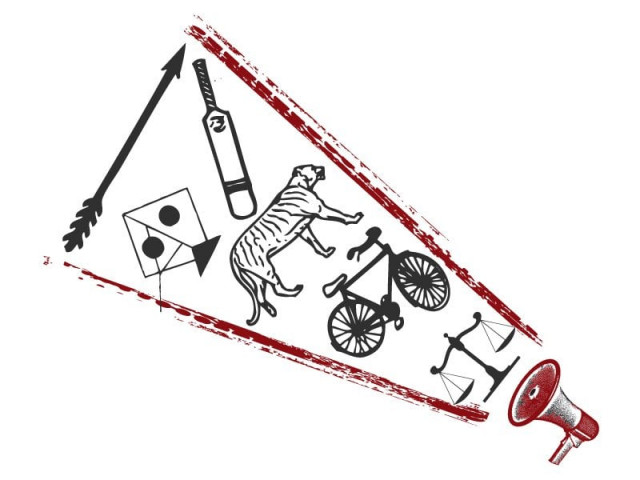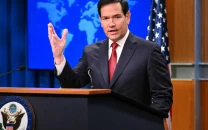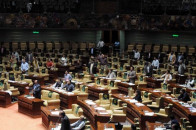Election 2013: What’s in an election symbol?
The number of registered parties far exceeds the number of available ECP symbols.

The number of registered parties far exceeds the number of available ECP symbols. DESIGN: FAIZAN DAWOOD
In a country where the literacy rate is abysmally low and political parties have relatively weak manifestos, the superiority of a party’s symbol is employed from time to time to persuade undecided and uninformed voters.
A ballot paper normally contains three columns: a serial number, the name of candidate and his/her party’s symbol. The election symbol is for obvious reasons taken on face value, both for the contesting candidates and the voters.
Procedure to allocate symbols
According to the Allocation of Symbols Order, 2002, the Election Commission of Pakistan (ECP) will notify a date for political parties to apply for election symbols soon after the election schedule is announced.
Parties, which have fulfilled two main preconditions; the holding of intra-party elections and the filing of party assets, are eligible to receive election symbols.
Symbol shortage
Interestingly, ECP has fallen short of election symbols as the number of registered parties outnumbers the available symbols. The number of registered parties stands at 227 at present, while only a total of 172 symbols are in the commission’s list of approved symbols. In past elections, the number of political parties contesting elections stood near 30 to 40.
If a political party is allotted a particular symbol in the past, it is considered its preferential right to get the same one in the next polls if it has followed the application rules for it. Recently, the commission decided to allot the ‘scale’ (balance) symnbol to Jamaat-e-Islami. PTI also wanted to contest the upcoming polls with the ‘scale’, claiming that the symbol represented the party’s name and its manifesto.
Under Clause 6 of the Allocation of Symbols Order, if a symbol is allotted to a combination of political parties in the previous elections and component parties then apply independently for the symbol in the upcoming polls, the allotment is decided through a draw.

Among the mainstream political parties, the ruling Pakistan Peoples Party has been contesting elections with an arrow as its symbol, the Pakistan Muslim League-Nawaz (PML-N) with a tiger, the Pakistan Muslim League-Quaid with a bicycle, the Muttahida Qaumi Movement with a kite, Pakistan Tehreek-e-Insaf with a cricket bat, and the Awami National Party with a lantern.
Exploiting symbols?
After the 9/11 attacks and the subsequent US invasion in Afghanistan, the Muttahida Majlis-e-Amal, a coalition of six religious parties including Jamaat-e-Islami (JI) and Jamiat Ulema-e-Islam Fazl, gained considerable popularity in the country, some of which was attributed to the alliance’s symbol.
The alliance, which was allocated a book as its symbol, allegedly attempted to exploit public sentiments in the 2002 elections, a time when anti-US sentiments were running high, by giving the impression that their party symbol represented the Holy Quran and Shariah.
The alliance secured the highest number of seats for any religious group ever in the history of the country and formed their government in two provinces. Fazlur Rehman’s JUI-F is now in queue for the book symbol in the upcoming polls. However, ECP is considering printing an open book with alphabets and digits to emphasise that it is just a ‘normal’ book.
Who would vote for a donkey?
Interestingly, sometimes the quarrel is over the similarity in party symbols. At a recently held by-poll an independent candidate ran with a cat as his symbol against a PML-N candidate. Later, PML-N complained that many of its voters could not differentiate between the two symbols, suggesting that the party numerous votes due to that reason.
Many symbols are considered inferior or derogatory in the country’s social context. In Pakistani culture a dog, jackal, donkey or an owl would be deemed derogatory. Similarly a “lota” has been considered derogatory since it a term widely used for turncoats.
The ECP recently eliminated a few election symbols, with the ‘lota’ being one of them, while the commission also introduced new symbols such as a missile, computer, mobile phone, watermelon, electric pole, audio cassette and pushcart, etc.
A banana, ladyfinger, vase, matchbox, bouquet, white radish and Peshawari chapel were among the withdrawn symbols.
Published in The Express Tribune, January 27th, 2013.



















COMMENTS
Comments are moderated and generally will be posted if they are on-topic and not abusive.
For more information, please see our Comments FAQ